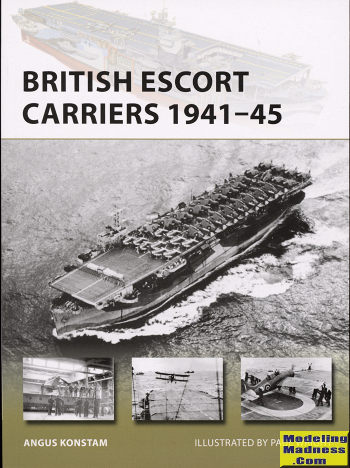 Next
up in Osprey's New Vanguard series is this nice offering on British Escort
Carriers. Fairly early in the war, it was realized that, as in WWI, nothing
seemed to be as good a deterrent against convoy attack by submarines as
airplanes. Aircraft could quickly spot a submarine and attack them with bombs
before they had a chance to fully submerge. However, WWII brought along another
issue and that was long range German bombers. These were often able to range
fairly far out into the ocean. Not only could they attack shipping on their own,
but were able to relay convoy location so that the U-boats would be able to set
a trap for them.
Next
up in Osprey's New Vanguard series is this nice offering on British Escort
Carriers. Fairly early in the war, it was realized that, as in WWI, nothing
seemed to be as good a deterrent against convoy attack by submarines as
airplanes. Aircraft could quickly spot a submarine and attack them with bombs
before they had a chance to fully submerge. However, WWII brought along another
issue and that was long range German bombers. These were often able to range
fairly far out into the ocean. Not only could they attack shipping on their own,
but were able to relay convoy location so that the U-boats would be able to set
a trap for them.
The British really didn't have much at all in the way of air protection
for convoys until they got close enough to the British Isles. Fleet carriers
were needed elsewhere and simply could not provide the air coverage needed for
all the various convoys. What was needed was something that could carry a plane
or two within the convoy itself. One early option was the CAM (Catapult Armed
Merchant) that could carry a Hurricane. This aircraft would be catapulted ahead
of the convoy to scout for subs and allow the convoy to change course to avoid
them. Problem was this was a one shot deal with the pilot usually having to
either bail out or ditch near the convoy.
Then there was the idea of the Auxiliary Carrier. This was a merchant
ship with the superstructure removed and a flight deck put in place. The
earliest had no elevators so the planes had to stay on deck. This made launch
and recovery operations lengthy as all the plane still on deck after launch had
to be moved forward and then returned aft after all planes were back. But they
were a first step. The British also developed MAC (Merchant Aircraft Carriers)
which had a flight deck, but were also able to carry cargo. These did not enter
service until very late in 1942 and were reconverted back after the war.
What was needed was a dedicated small aircraft carrier that was built on
a merchant hull and could be quickly made. This is where the US came into play.
A fully functional aircraft carrier was designed for a large merchant hull and
these were able to be fairly quickly built. Dozens were built during the war
with about half going to the Royal Navy. They were useful as convoy protection
and also for ferrying aircraft to places where they were needed. Indeed, many
USN operated escort carriers were use solely as aircraft transports, carrying
new fighters to various places in the Pacific and Med, returning with those that
were in need of major repair.
This book covers the developments of various ship types and also
provides some information on the various classes. A very brief history of each
ship is provided. There is also a two page 'in action' section at the end of the
book that so abruptly quits that it takes one by surprise. The author has a bit
of difficulty identifying aircraft, but that is a fairly minor detail as most of
us can tell the difference between a Fulmar and a Barracuda (for instance). In
line with other books in this series, there are great period photos and some
nice artwork to go along with things. A nicely done book and well worth picking
up.
July 2019
For more on the complete line of Osprey books,
visit www.ospreypublishing.com. If you would like your product reviewed fairly and
fairly quickly, please
contact
the editor or see other details in the
Note to
Contributors.
 Next
up in Osprey's New Vanguard series is this nice offering on British Escort
Carriers. Fairly early in the war, it was realized that, as in WWI, nothing
seemed to be as good a deterrent against convoy attack by submarines as
airplanes. Aircraft could quickly spot a submarine and attack them with bombs
before they had a chance to fully submerge. However, WWII brought along another
issue and that was long range German bombers. These were often able to range
fairly far out into the ocean. Not only could they attack shipping on their own,
but were able to relay convoy location so that the U-boats would be able to set
a trap for them.
Next
up in Osprey's New Vanguard series is this nice offering on British Escort
Carriers. Fairly early in the war, it was realized that, as in WWI, nothing
seemed to be as good a deterrent against convoy attack by submarines as
airplanes. Aircraft could quickly spot a submarine and attack them with bombs
before they had a chance to fully submerge. However, WWII brought along another
issue and that was long range German bombers. These were often able to range
fairly far out into the ocean. Not only could they attack shipping on their own,
but were able to relay convoy location so that the U-boats would be able to set
a trap for them.